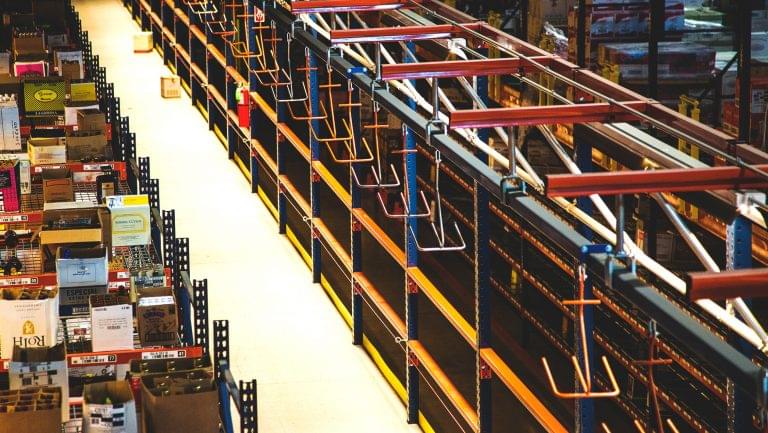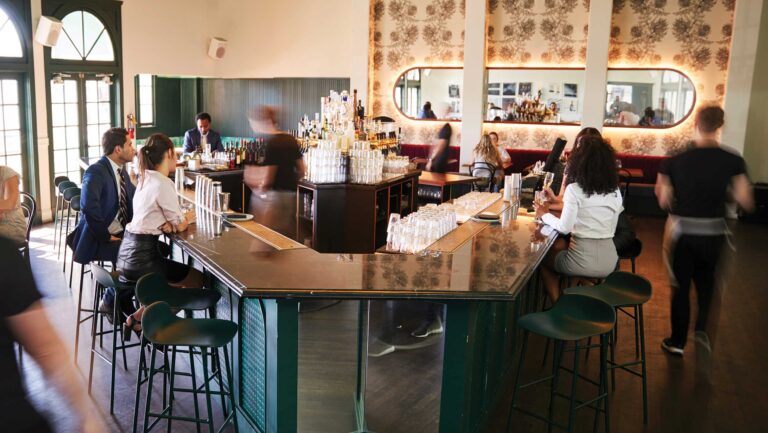The company Breakthru Beverage Group, a leading North American alcohol distributor, wanted to get closer to its customers in the important Chicago market, and it had a choice. Breakthru was eyeing two locations for its new regional distribution center and headquarters, one about 35 miles outside of downtown Chicago, and the second much closer to the city, in the suburb of Cicero. “Land prices are a little bit higher in the city,” says Arthur Wirtz, Breakthru’s executive vice president of operations. “We could have gone 35 miles outside of the city and gotten a lower land cost and potentially more land.”
Perhaps the company would have been forced to do just that—say 10 years ago, when warehouse automation was still in its relative infancy. But Wirtz, whose family has been in the alcohol distribution business for many years and who is considered one of the more progressive and tech-savvy leaders in the industry today, wanted to reach for the sky, literally.
So the company chose the smaller Cicero location. Wirtz and his team’s idea was to harness the power of automation to make it work. Instead of spreading this new facility across a lot of expensive acreage, they decided to build it higher—45 feet, to be exact—and install a state-of-the-art automatic storage and retrieval system (AS/RS).

Don’t miss the latest drinks industry news and insights. Sign up for our award-winning newsletters and get insider intel, resources, and trends delivered to your inbox every week.
The AS/RS they installed has enabled the company to push its storage racks higher into the sky, with an automated crane shuffling back and forth among them, storing and retrieving pallets of fast-moving product in minutes.
The new location worked as planned, allowing Breakthru to cut down on drive time to get to its customers. Now it’s able to operate more efficiently, completing more deliveries per route. “We got closer to the population center, closer to our customers, which required fewer routes, less traffic,” says Wirtz. “And we’ve consolidated four different facilities—Elk Grove, Wood Dale, Bensenville, and Schaumburg—in the Chicago area into one.”

More Distributors Turn to Automation
Breakthru’s experience in Illinois is an example of how automation is revolutionizing the alcohol beverage supply chain today. As the industry continues to consolidate—Breakthru was formed in 2016 by the merger of Wirtz and Charmer Sunbelt—automation is allowing distributors to stay on top of increasing SKUs and labor costs in safe and more efficient ways. The higher volume of business can justify the higher costs of the automation systems and also allow for a quicker return on investment, or ROI.
The wine and spirits distributor Martignetti Companies is another example of a wholesaler that’s using automation to consolidate its operations and increase both efficiency and speed to market, while also positioning itself for future growth opportunities. Martignetti was able to consolidate two former warehouses into a newly constructed 50-foot-high facility in Taunton, Massachusetts, that makes use of three AS/RS systems to automatically store and retrieve thousands of pallets each day.
“We managed to do it by automation,” says Ed DeVito, Martignetti’s senior vice president of Warehouse & Delivery Operations. “We average around 3 pallets per minute, or 180 pallets per hour, with this system.” A 600-foot conveyor with a capacity for 100 pallets feeds the AS/RS system from the receiving dock. The AS/RS, from Westfalia, is run by a Savanna.NET warehouse execution system, which is interfaced with Shiraz, a warehouse control system from DMW&H. Shiraz manages a total of five miles of conveyors; it interfaces not only with the AS/RS crane system but also with the facility’s Lucas voice-picking system in the facility’s bottle room. The state-of-the-art facility also includes an I-Pack automated packaging system from DMW&H, solar panels on the roof, and hydrogen fuel stations supported by Nuvera to cleanly power an array of material-handling equipment supplied by NITCO.
“When you use advanced automation, the result is going to be increased efficiencies,” says DeVito, “and it can also reduce the footprint needed and the costs that go with that footprint. Our warehouse, for example, is 600,000 square feet. If we didn’t include the AS/RS we would have had to expand the building by an additional 150,000 square feet. “With an AS/RS system,” DeVito adds, “the lift that you get on productivity is substantial.”

The system gives Martignetti the ability to select up to 8,000 cases per hour, DeVito says, and process those into the trucks, compared with the company’s former system, which allowed for a maximum of 4,000 cases per hour. “Doubling the throughput,” he says, “gave us the ability to consolidate all our operations under the one roof.”
The consolidation has enabled the company to streamline its deliveries. “We were able to reduce multiple deliveries to our customers,” DeVito explains. “If an account had deliveries from the Norwood facility and deliveries from the Braintree facility, they are now able to get all the product on one truck coming out of the Taunton facility.”
The facility’s AS/RS system, DeVito says, can store pallets up to ten deep and five high, and it can commingle different items. “So inside the crane system we have a total of 18,500 locations,” he says, “and we can fit just over a million cases inside it.” DeVito says the system’s fill rate represents more than 99 percent of 75 percent of the company’s total volume.
Additionally, the company’s IT team has added the ability for the system to replenish the bottle room automatically, whereas in the past all of those items had to be individually picked. Says DeVito, “It was a much more laborious process than what we have today.” Shiraz also keeps an eye on cases going through a scan tunnel and automatically diverts any potential mispicks that made it through the system to cut down on order errors.
Other Factors Driving Automation
In today’s tight labor market, warehouse workers can be both highly paid (unionized worker salaries can be $80,000 or higher) and increasingly hard to find. This fact increases the ROI for automation while solving recruitment challenges. As Paul Laman, the vice president of DMW&H, a leading provider of automated systems to wine and spirits distributors in the U.S., estimates, “If you replace 40 workers at a salary of $80,000 a year, that’s over $3 million, and it doesn’t take very many years to pay off one of these $10 million–plus systems.”
Matthew Ellis, a principal of Precision Distribution Consulting (PDC), says that until recently there had been a lot of discussion about automation in the alcohol industry, but not as much adoption. “I have a feeling that’s about to change,” he says. “And the main driver is simply the workforce. The orders and work are getting more complicated because of the demands of the customer. And the workforce … has less of an appetite to do that type of work—and the labor costs are going up.
“I will not be surprised,” he continues, “if there are a lot more automation systems in the next few years than there were in the previous five, just because of the labor force.”
In fact, such industry trends are even leading some vendors to reposition themselves. Take Twinlode, for example. While it used to offer only manual racking solutions, it has reoriented itself to include warehouse automation, creating a division to focus just on that. “A few years ago we started to see more and more of our customers expressing interest in automation,” says Mike Klaer, Twinlode’s president. So the company spent years researching what its customers were looking for and spent a lot of time in Europe, where warehouse automation has been commonly used for some time. Today, Twinlode’s automation division acts as a systems integrator, building customized warehouse automation solutions for its customers.
Klaer says that another major factor driving the adoption of warehouse automation in the alcohol industry are changes in the retail channel. “The Walmarts and Costcos and Sam’s Clubs of the world have increasing expectations,” he says. “Instead of buying a pallet of something, now they might buy a bottle of something, or a case of something, or a layer of something.” He points out that these retailers might buy a pallet with 30 different SKUs on it, rather than just five or six, as they did previously. The supplying “warehouses have to become a lot more flexible,” he says. “Their customers’ demands are much, much higher and much different than they were 10 years ago.”
Helping a Growing Industry
Given all these reasons, it’s probably not surprising that some of the latest statistics show an industry increasingly turning to automation. According to DMW&H, in 1994, when the company provided its first system to the wine and spirits industry, there were only four wine and spirits wholesalers that employed wave-based picking of orders, where the orders are picked in “waves” throughout the day from consolidated lists, resulting in fewer trips back and forth. Today, in comparison, there are more than 80 such systems in use in the industry. Says Laman, “Wave picking allows the operation team to pick large groups of orders, and the sortation equipment allocates it down to the order level to each door.”
Furthermore, in 2000, according to DMW&H, only one or two systems that could sustain a production rate of 4,000 cartons per hour were active in the industry. Now there are at least 12 that can produce 5,000 an hour or more.
Automation is not just providing a critical solution to the problems facing alcohol distributors. Alcohol manufacturers in some segments of the industry who are facing runaway growth are turning to automation for the first time, or upgrading their existing systems. Take the example of craft beer. Boulevard Brewing Company in Kansas City, Missouri, for one, had been struggling to deal with bottlenecks on its production line until it turned to an automated palletizing solution from Honeywell Intelligrated.
“We had taken the vintage equipment that started the company as far as it could go,” says Mike Utz, a plant engineer at Boulevard. With 11 workers on the floor, the facility produced about 300 bottles per minute. Three workers alternated the manual end-of-line palletizing, stacking cases weighing up to 30 pounds each at a rate of 12 cases per minute.

The brewery also faced space constraints. Located in a completely developed urban area just south of downtown, it had a limited footprint to build on, and every piece of equipment needed to be compact, functional, and efficient in both its use of space and functioning.
Boulevard turned to the Honeywell Intelligrated Alvey 780 mid-speed palletizer, which was able to both maximize space efficiency and provide gentle product handling. The entire operation was able to move from the 11 workers running a maximum of 300 bottles per minute to 5 workers bottling 500 bottles per minute. A total of 25 to 30 cases are palletized by the machine per minute, a 100 percent increase over Boulevard’s previous manual palletizing methods. “The benefits we’ve received from the new Alvey palletizer,” says Utz, “have been remarkable.”
Warehouse Automation Today
PDC’s Ellis likes to split automation into two categories. The first type being used by alcohol companies in the U.S. today, which he refers to simply as “automation,” involves solutions that rely completely on machines, such as the AS/RS system in the Breakthru Beverage example. The second, which he calls “mechanization,” involves machines used in conjunction with human workers. An example of this is pick to belt, where a human picks the case and puts it on the conveyor belt but the process is directed by a computer-based sequence. Pick to belt has been more common in the wine and spirits world, where orders can consist of mixed products. But as craft beer has become more popular, this type of picking is becoming more common in the beer industry as well.
Among the most extensive automation investments is an AS/RS system, as in the Breakthru Beverage and Martignetti examples, which uses a crane to store and retrieve fast-moving full pallet-loads of product. Although they’re a good fit for fast-moving products, AS/RS systems are still somewhat rare in the U.S. alcohol distribution industry, as most distributors use case shuttle systems.

An AS/RS system’s value depends on the volume a distributor is handling, as well as the available warehouse space and the cost of real estate. “Thirty years ago, people had 20-foot-clear warehouses,” says Laman. “Then they moved to 30 feet. Now they’re basically up to 40 feet. But to take advantage of that height, you’ve got to buy more technology that holds the product more densely. So you’re saving on overall building cost by going higher and automating it further so you get maximum density on your storage.”
Along with AS/RS, case shuttle systems are becoming more widespread in the industry. These systems shuttle cases in and out of racks, allowing for easier storage and retrieval. “A shuttle is basically a closet with 10,000 single-case storage locations in it,” says Laman. “It allows you to pick all the slow stuff during the day, put it in the shuttle, and when it comes time to do the production during the night shift, the shuttle releases the cases that correspond to the waves that are going through the rest of the system.”
Requiring the least investment is a pick-to-voice system, in which the pickers are told by the computer the location and quantity of what to pick. Pick-to-voice systems have been in widespread use for quite some time throughout the industry. Such a system costs about $200,000 to $300,000 today and is a good fit for, say, a smaller, rural beer wholesaler, whereas, according to Laman, a large metropolitan wholesaler handling 13,000 SKUs and 10 million cases per year of wine and spirits can end up spending $30 million on its total material handling systems.
Overseeing these automation systems are the brains of the solutions—the warehouse management systems (WMS). And according to Sean Elliott, the chief technology officer of WMS provider HighJump, alcohol distributors today are looking for more agile WMS systems that can be adapted to the unique challenges that each company faces.”The question,” he says, “is, How easy is it to configure or personalize that solution to suit the unique nuances of your market, of your geography, of your business culture—and really to create a solution that while enterprising in nature and solving some common problems, is solving them in a way that is very uniquely tailored to your business circumstance?”
A craft brewer’s business, for example, can be affected by a variety of local laws. HighJump’s WMSs can be adapted to these different situations. “As the laws evolve,” says Elliott, “it’s very easy for our customers to adapt and respond to changing market conditions and to come up with unique offerings—like selling samples through their taprooms when certain states in the Southeast made that available—without having to continuously rely on us to make those changes on their behalf.”
What the Future Holds
The alcohol distribution industry as a whole does not have a reputation for being on the cutting edge of technology, but some companies, like Breakthru, make an effort to stay abreast of new innovations, including those in other industries. “It’s essential for us and our supplier partners,” says Breakthru’s Wirtz, “to continually look at automation and other trends in technology, and I think the changing landscape of wholesale distribution is driving a lot of that.”
Additional automation technologies for alcohol warehouses that may gain popularity in the coming years include dispenser and goods-to-person systems. And drones might soon be commonly spotted flying around alcohol warehouses.
The company PINC Solutions has come up with a way to use drones to track assets in truck yards, and it’s now looking to apply that solution to managing warehouse inventory. While having a drone buzzing around a warehouse may seem a bit too sci-fi for some, Matt Yearling, PINC’s CEO, says it’s already being done in the food industry, among others. “Ninety percent of all inventory is stationary,” says Yearling. “The process of reconciling inventory has been a manual process with pen and paper, barcode scanners, or whatever the case may be. It’s the most laborious and least preferred job—and ripe for automation.”
Yearling explains that the robot drone technology is self-contained. A drone relies on its own cameras to read product labels and doesn’t require any additional technology to be installed for it to work. “We basically train the robot to understand the inventory labeling mechanisms that are appropriate for that particular customer,” he says, adding that the technology enables companies to redirect their human labor force to other tasks and automate “the manual, repetitive tasks of understanding what inventory you have, and doing that faster, better, and cheaper than how it’s done today—hundreds of times faster.”

Companies that are considering automating some part of their warehouse operations should be ready to engage in a thorough review of their current operations as part of the planning process, including researching and preparing data about how much product the automated system will need to handle. “A lot of customers don’t realize the time and effort and amount of work it takes to properly design an automated system,” says Twinlode’s Klaer. And that’s especially true, he emphasizes, for companies planning to implement the larger, more involved systems. Presenting an accurate assessment of a company’s operations will result in a warehouse automation system that can properly handle the alcohol distribution operation’s needs and yield greater efficiencies and a better overall investment.

Dispatch
Sign up for our award-winning newsletter
Don’t miss the latest drinks industry news and insights—delivered to your inbox every week.
Andrew Kaplan is a freelance writer based in New York City. He was managing editor of Beverage World magazine for 14 years and has worked for a variety of other food and beverage-related publications, and also newspapers. Follow him on Twitter at @andrewkap.







